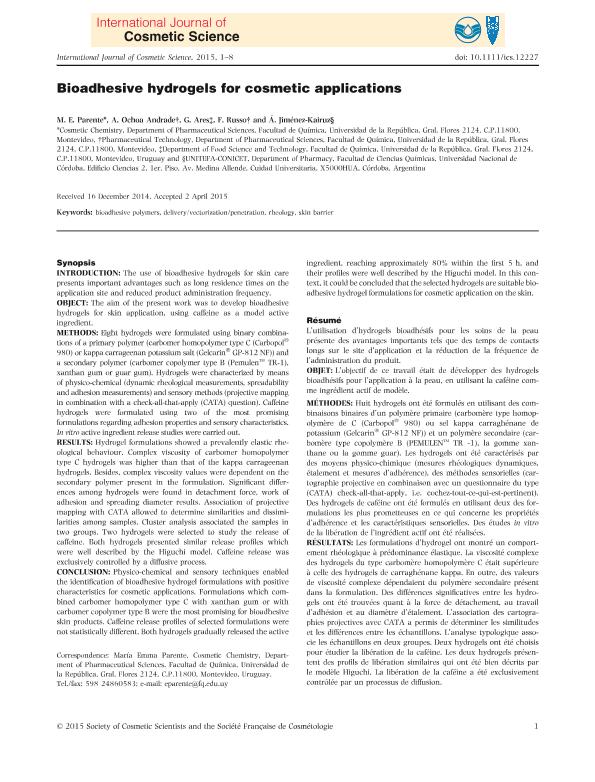Mostrar el registro sencillo del ítem
dc.contributor.author
Parente, M. E.
dc.contributor.author
Ochoa Andrade, A.
dc.contributor.author
Ares, G.
dc.contributor.author
Russo, F.
dc.contributor.author
Jimenez Kairuz, Alvaro Federico

dc.date.available
2018-10-23T20:14:43Z
dc.date.issued
2015-10
dc.identifier.citation
Parente, M. E.; Ochoa Andrade, A.; Ares, G.; Russo, F.; Jimenez Kairuz, Alvaro Federico; Bioadhesive hydrogels for cosmetic applications; Wiley; International Journal Of Cosmetic Science (print); 37; 5; 10-2015; 511-518
dc.identifier.issn
0142-5463
dc.identifier.uri
http://hdl.handle.net/11336/62960
dc.description.abstract
Introduction: The use of bioadhesive hydrogels for skin care presents important advantages such as long residence times on the application site and reduced product administration frequency. Object: The aim of the present work was to develop bioadhesive hydrogels for skin application, using caffeine as a model active ingredient. Methods: Eight hydrogels were formulated using binary combinations of a primary polymer (carbomer homopolymer type C (Carbopol® 980) or kappa carrageenan potassium salt (Gelcarin® GP‐812 NF)) and a secondary polymer (carbomer copolymer type B (Pemulen™ TR‐1), xanthan gum or guar gum). Hydrogels were characterized by means of physico‐chemical (dynamic rheological measurements, spreadability and adhesion measurements) and sensory methods (projective mapping in combination with a check‐all‐that‐apply (CATA) question). Caffeine hydrogels were formulated using two of the most promising formulations regarding adhesion properties and sensory characteristics. In vitro active ingredient release studies were carried out. Results: Hydrogel formulations showed a prevalently elastic rheological behaviour. Complex viscosity of carbomer homopolymer type C hydrogels was higher than that of the kappa carrageenan hydrogels. Besides, complex viscosity values were dependent on the secondary polymer present in the formulation. Significant differences among hydrogels were found in detachment force, work of adhesion and spreading diameter results. Association of projective mapping with CATA allowed to determine similarities and dissimilarities among samples. Cluster analysis associated the samples in two groups. Two hydrogels were selected to study the release of caffeine. Both hydrogels presented similar release profiles which were well described by the Higuchi model. Caffeine release was exclusively controlled by a diffusive process. Conclusion: Physico‐chemical and sensory techniques enabled the identification of bioadhesive hydrogel formulations with positive characteristics for cosmetic applications. Formulations which combined carbomer homopolymer type C with xanthan gum or with carbomer copolymer type B were the most promising for bioadhesive skin products. Caffeine release profiles of selected formulations were not statistically different. Both hydrogels gradually released the active ingredient, reaching approximately 80% within the first 5 h, and their profiles were well described by the Higuchi model. In this context, it could be concluded that the selected hydrogels are suitable bioadhesive hydrogel formulations for cosmetic application on the skin.
dc.format
application/pdf
dc.language.iso
eng
dc.publisher
Wiley

dc.rights
info:eu-repo/semantics/openAccess
dc.rights.uri
https://creativecommons.org/licenses/by-nc-sa/2.5/ar/
dc.subject
Bioadhesive Polymers
dc.subject
Delivery/Vectorization/Penetration
dc.subject
Rheology
dc.subject
Skin Barrier
dc.subject.classification
Otras Ciencias Químicas

dc.subject.classification
Ciencias Químicas

dc.subject.classification
CIENCIAS NATURALES Y EXACTAS

dc.title
Bioadhesive hydrogels for cosmetic applications
dc.type
info:eu-repo/semantics/article
dc.type
info:ar-repo/semantics/artículo
dc.type
info:eu-repo/semantics/publishedVersion
dc.date.updated
2018-10-23T13:42:28Z
dc.journal.volume
37
dc.journal.number
5
dc.journal.pagination
511-518
dc.journal.pais
Estados Unidos

dc.description.fil
Fil: Parente, M. E.. Universidad de la República; Uruguay
dc.description.fil
Fil: Ochoa Andrade, A.. Universidad de la República; Uruguay
dc.description.fil
Fil: Ares, G.. Universidad de la República; Uruguay
dc.description.fil
Fil: Russo, F.. Universidad de la República; Uruguay
dc.description.fil
Fil: Jimenez Kairuz, Alvaro Federico. Consejo Nacional de Investigaciones Científicas y Técnicas. Centro Científico Tecnológico Conicet - Córdoba. Unidad de Investigación y Desarrollo en Tecnología Farmacéutica. Universidad Nacional de Córdoba. Facultad de Ciencias Químicas. Unidad de Investigación y Desarrollo en Tecnología Farmacéutica; Argentina
dc.journal.title
International Journal Of Cosmetic Science (print)

dc.relation.alternativeid
info:eu-repo/semantics/altIdentifier/doi/http://dx.doi.org/10.1111/ics.12227
dc.relation.alternativeid
info:eu-repo/semantics/altIdentifier/url/https://onlinelibrary.wiley.com/doi/abs/10.1111/ics.12227
Archivos asociados
